
Cassin class destroyers (1913)
 USN Fleet Destroyers (1912-1935): USS Cassin, Cummings, Downes, Duncan, Aylwin, Parker, Benham, Balch (DD-43-50)
USN Fleet Destroyers (1912-1935): USS Cassin, Cummings, Downes, Duncan, Aylwin, Parker, Benham, Balch (DD-43-50)
The first USN “1000 tonners” Destroyers
After the very early Bainbrige and the 800-tonners (late called “flivvers” – Paulding & Smith) the USN seeked a new incremental step based on the same desig, just upscaled the previous design, prpducing a four-stacked class reaching 1,000 tonnes standard and thus called retrospectively the “1000-tonners”. Four were ordered first, known as the Cassin class. They innovated as being the first to carry the new 4-inch (102 mm)/50 caliber gun while gaining two more torpedo tubes. Despite of a more powerful machinery, top speed fell to 30 knots (56 km/h; 35 mph). All served as co,voy escorts and three agains as USCG’s “rum-runners” until 1932. They led to the Aylwin class. #USN #destroyer #ww1 #usnavy
The need for new scouts
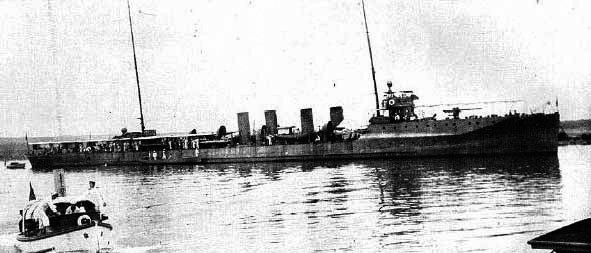
USS Cassin, date unknown
The initial motivation was to increase the standard to a normal displacement of over 1,000 tons to combine a heavier armament with better cruising range. The main goal was to be able to cross the Atlantic in one go if possible. The USN’s three modern scout cruisers of the Chester class, totally unsufficient to offer screeing to the fleet of new battleships, and so, these new fleet destroyers were to be used as scouts. The two-shaft direct drive turbines engineering arrangement was repeated as globally satisfactory, although poor performance of the early cruising turbines conducted to reciprocating engines being recalled for cruising. In fact, DD-43 and DD-44 (the first two) used triple expansion engines which could be clutched to one shaft for cruising and the other two followed suite.
Order and Contruction
Two classes of “1000-tonners” were defined in FY1912. It was hoped that during the short span between the Cassin and Aylwin, a few incremental improvements could be made, before swapping on a new, bolder upgrade (which were ordered in FY1913) turning to be the eight O’Brien class. In fact both the Cassin and Aylwin ended built concurrently, and the whole considered by many authors to be a sub-class of the Cassins, or all the same so much so differences were tiny.
So for the sake of clarity we are going to see them in one swoop.
A new standard: The “1000 tonners”
What is really important there, is that the Cassin and following constituted five classes (or five depending of who is speaking). In all, this “superclass” included 26 destroyers. After the Cassins/Aylwins, the six O’Briens, six Tuckers, and six Sampsons. Arguably the Tucker were repeats of the O’Brien, so it left use with three main types in reality. They were commissioned in 1913–17 and thus the last prewar US destroyers.
They all combined the same gun armament of four 4 inch (102 mm) but torpedo armament was greatly increased, with a displacement rising to 100 tons. The Cassin/Aylwin stuck to the previous 18-inch (450 mm) torpedo tubes but had two more, in four twin broadside mounts but O’Briens had a new 21-inch (533 mm) caliber torpedo, still keeping eight, as the Tucker. The new Sampsons went further and stocked no less than twelve 21 inch (533 mm) tubes, when switching on triple mounts. The first brand new design, first “flush deck” types were the Caldwell class, which retained both gun and torpedo armament of the Sampsons with 100 tons more and a new, more powerful engineering plant. They were the true prototypes for the wartime Wickes/Clemsons. The Sampson class was also the first to introduce an anti-aircraft armament with two 1-pounder (37 mm) autocannons. After getting rid of the issues causes by turbines they were reintroduced with the Tucker/Sampson classes. The arrangemen was repeated and improved on the Caldwell, and adopted for the mass-built “four stackers” of 1917-1921.
Design of the class
Aylwin: 2nd Generation of “1000 tonners”
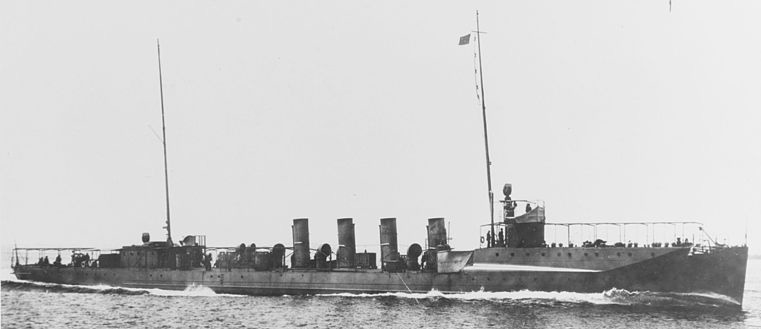
The Aylwin were four destroyers built at Cramp (William Cramp & Sons in Philadelphia). In fact USS Aylwin was launched well before USS Cassin (23 November 1912 vs. 20 May 1913) and so the class in European publications is sometimes called “Aylwin class”. They were full repeats of the Cassin class assimilated as the very same Cassin class in Conways, which however made a distinction between the Pauldings and Monaghans.
Design of the class
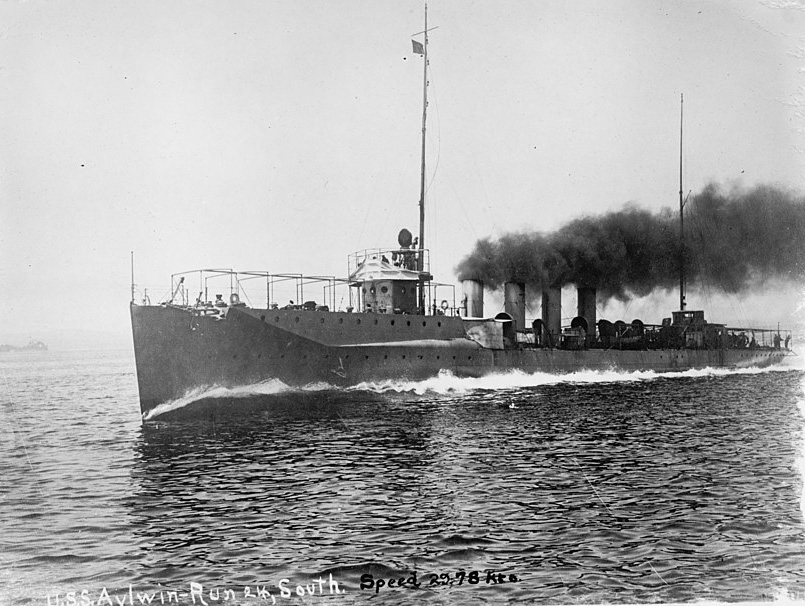
Hull and general design
As the first “thousand tonner” the Cassin and Aylwins were a significant improvement over the Paulding/Monaghan, Based on a displacement of 1,036 tons (on normal load), 1,165 tons fully loaded, for an overall lenght 305 ft 3 in (93.04 m) overall and 30 ft 4 in (9.25 m) in beam. Their mean draft reached 9 ft 5 in (2.87 m). The previous ships reached 289-293 ft for 26-27 ft in beam and “only” 885 tonnes fully loaded.
Externally they shared the same basic silhouette, with the caracteristic short forecastle, small open bridge and four tall funnels, close together. The “four stacker” pattern remained standard until 1921 on all US DDs. Wireless telegraphy as installed had cabled resting on the two masts, foremast behind the bridge and mainmast. Unfortunately profiles and plans are near-impossible to find. Only those of the following O’Brien are known. So photos shows a relatively large quarterdeck house aft, on which the mainmast was planted. It also housed the radio room. The axial aft gun was located behind, but no TT. They were all on the broadside amidships.
Powerplant
The Cassin/Aylwin were given the same powerplant in principle but dependong of the yard, various brands of turbines and boilers.
The Cassin/Cummings defined the standard although the Data Book for 1912 shows the first two indeed had the same four Normand boilers (They were built at Bath Iron Works) and two direct-drive Parsons-type steam turbines on two shafts. They produced a total of 16,000 shp (12,000 kW). Theu would inaugrate two small triple-expansion engines which could be clutched to one shaft for economical cruising. Only better, higher temp/pressure boilers would resolve the poor performances of early steam turbines with new geared cruising turbines of the Caldwell and following. The next USS Downes (from New York SB) had Thornycroft boilers, USS Duncan (From Fore River Yard, Mass.) had Yarrow boilers and both were given Curtis steam turbines and the same two triple-expansion cruising engines. The choice of having both turbines and TE engines dictated a longer hull indeed.
Downes made 29.14 knots (53.97 km/h; 33.53 mph) on trials at 14,254 shp (10,629 kW). Normal fuel oil capacity was 312 tons.[4]
The Aylwin were all from Cramp and thus, had the same four White-Forster boilers feeding stem to two Cramp direct-drive turbines. The four destroyers exceeded the 16,000 shp output on trials. But like the Cassins they had the same Compound steam engines clutchable onto shafts for economical and medium-speed cruising. Aylwin managed to reach 29.6 knots (54.8 km/h; 34.1 mph) on trials based on 16,286 shp (12,144 kW) like her sisters (so less than the requested 30 kts), and standard fuel oil capacity was 307 tons in peacetime. It could be increased in wartime.
Armament
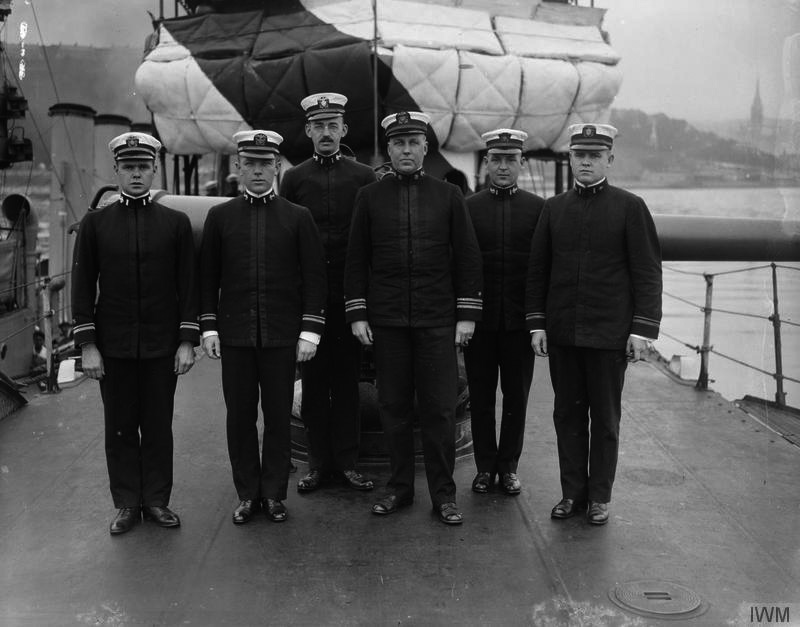
USS Cassin’s crew
The Cassin class were a true improvement in terms of firepower, by introducing 4-in/50 guns (102 mm) which shells had twice the weight of the previous 3-in (76 mm) of the Pauldings. This choice had them trading one gun (from five to four) but the new caliber was such an improvement there was no second though about it. In fact this became the standard for all US Destroyers until 1922. The only difference was their organization: On the Cassins and up to the Sampsons, it was the same configuration as before, with a forescastle gun, two at the lower deck under recess, also facing forward, and one aft, axial. The 1917 Caldwell would introduce the new “lozenge” pattern.
During early phases of the design, the board even hoped to replace at least one of 3-in/50 gun with a long-recoil 5-in (127mm) but C&R managed though it was a stability issue and promoted instead a uniform battery of four 102mm/50, and a fourth twin 450mm TT as replacing the fifth gun in a way.
They Aylwin retained the Cassins’ armament of four 4-inch (102 mm)/50 caliber Mark 9 guns and eight 18-inch (450 mm) torpedo tubes in twin broadside mounts. This broadside with twin mounts each side reflected the General Board’s desire to have torpedoes remaining for a second one instead of having to retire and reload. The class also received one or two depth charge racks for convoy escort in 1917-18. USS Benham tested four twin 4-inch mounts in 1917. But she proved top-heavy an reverted back to single mounts before her first overseas deployment. The idea of stacking double mounts would resurface in 1918 on the larger Clemsons though. In 1929 they all recuved the same additional 3-inch (76 mm)/23 anti-aircraft gun, placed immediately aft of the forecastle main gun.
Main guns: Four 4-in/50 Mark 9
The serie started with the Mark 7 (1898), first used as secondary guns on the Arkansas class monitors. The Mark 8 were an improved version designed from 1905, but they gave apparently little satisfaction and were reworked from 1910, ending with threat standard Mark 9. Its general performances were such that it became also an allied standard with more than 400 transferred to the British. They were still in service in WW2 on a large quantity of ships by the way.
It was light weight and thus easy to handle, fast-firing, fast revolving and traversing.
Quick Specs:
ROF 8-9 rpm, 64.75 lbs. (29.4 kg) complete round, 2,900 fps (884 mps), 15,000 yards (13,720 m/19°. Each destroyer carried 300 rounds total.
More on navweaps.com
Torpedo Tubes: Four twin 18-in Mark 5
They used the standard Whitehead torpedo Mk.5, available since 1910.
Diameter: 17.7 in (45 cm)
Length: 204 in (520 cm)
Weight: 1,452 lb (659 kg)
Warhead: 200 lb (91 kg) Guncotton
powerplant: Heated Air-flask Brotherhood pattern engine
Speed settings: 27 kn (50 km/h)4,000 yd (3,700 m) or 36 kn (67 km/h)/2,000 yd (1,800 m) or 40 kn (74 km/h)/1,000 yd (910 m)
ASW armament (1917-18)
In 1917-1918 to perform better as ASW ships, the class was equipped with two depht charge racks (DCR) and a single thrower or DCT, which was the “Y-gun”, called that way before its shape. It throwed two depht-charges at once.
The latter were probably of the Mark I type (1916) weighting 100 lbs. (45 kg) with a 50 lbs. (23 kg) wet gun-cotton exploser ad two settings, 25 and 100 feet (8 – 30 m).
⚙ Cassin class specifications |
|
| Displacement | 1,020 tons (normal) 1,139 tons (full load) |
| Dimensions | 305 ft 3 in x 30 ft 4 in x 9 ft 3 in (93.04 x 9.25 x 2.82 m) |
| Propulsion | 2 shafts DD Turbines, 4 boilers 16,000 shp (12,000 kW) as designed |
| Speed | 29 kn (54 km/h; 33 mph) |
| Range | 312-290 tons oil (fuel) 4,500 nmi () at 16 kn |
| Armament | 4 x 4-in/50 guns, 4×2 18-in torpedo tubes* |
| Crew | 5 officers, 93 ratings |
*In 1918, One DCT Y-gun, 2 DCR.
Modifications
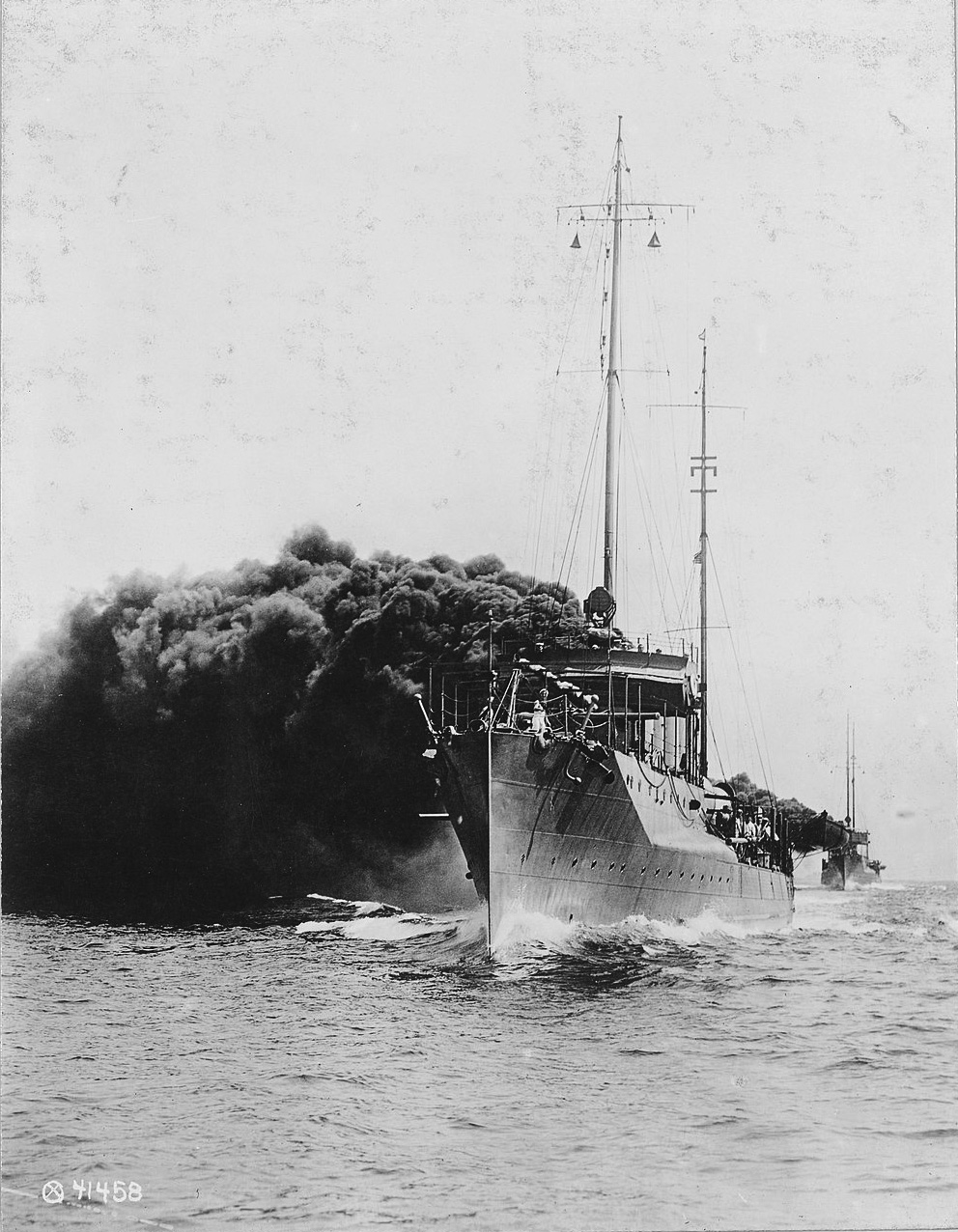
The prow of USS Cassin
In addition to the dedicated ASW armament added in 1917-18, it seems the most obvious change was their new bridge. All eight ships arrived like their predecessors wit a barebones “open deck”, meaning the small tower supported a platform on which was installed all the essential command for the captain and bridge officers: A chadburn and voice pipes. There was also a telephone to communicate with the machinery spaced. The forward steering wheel was located in the structure below and there was an open deck aft backup steering wheel aft, before the rear gun.
In 1917 however when prepared for overseas deployment they were given a new, fixed bridge. Indeed only canvas on barriers were the standard, but they had a hard time coping with heavy weather spray as the forecastle as short.
The same approach and standard design recommanded bu BuShip was called upon as used on the prevous Paulding/Monaghans. It was composed of a triangular-shaped beak like structure, lighlty buil, but still enough to break incoming waves and bedind were located a serie of ten glass windows, five on either size of the angled face, and two larger ones on sides. This was still open top though. Right behind was located a platform with a single projector. The main mast receiceved also a larger spotting top, designed for submarine spotting, alshough ealry hydrophones were probably fitted as standard in 1918.
The lower level forward guns either side of the forecastle behind recesses were excessively “wet” in even moderate weather and so canvas were applied when not in use. This issue of “wet guns” also common on early USN battleships barbette, was resolved only from the Caldwell class, which had them replocated on either beam between funnels on high platforms, way out of any sprey. This explains why the artillery arrangement and limited speed was seen as drawbacks of the design and they did not stayed long in service unlike the flush-deckers.
In the 1920-30s patroling for the Coast Guard on the great lakes was no longer an issue for these guns…
Speaking of which, modifications also occured in Coast Guard service:
They lost all their main guns bar one, and all their torpedo tubes but retained their newly added AA gun. This allowed them to reclaim some speed also, although moderated by their worn-out machinery.
Read More
Books
Bauer, K. Jack; Roberts, Stephen S. (1991). Register of Ships of the USN, 1775–1990: Major Combatants. Greenwood Press.
Friedman, Norman (2004). US Destroyers: An Illustrated Design History (Revised ed.). NIP
Gardiner, Robert; Gray, Randal (1985). Conway’s All the World’s Fighting Ships 1906–1921
Silverstone, Paul H. (1970). U.S. Warships of World War I. London: Ian Allan.
Author’s profile:
Links
https://destroyerhistory.org/early/usscassin/
http://www.historyofwar.org/articles/weapons_cassin_class_destroyers.html
http://www.navsource.org/archives/05/043.htm
http://www.navypedia.org/ships/usa/us_dd_cassin.htm
www.destroyers.org/tcs-ships/early-destroyer-history
navsource.org
navweaps.com/Weapons/WTUS_PreWWII
https://tmg110.tripod.com/usn_4pd.htm
https://en.wikipedia.org/wiki/Cassin-class_destroyer
Model Kits
None found so far
 USS Cassin
USS Cassin
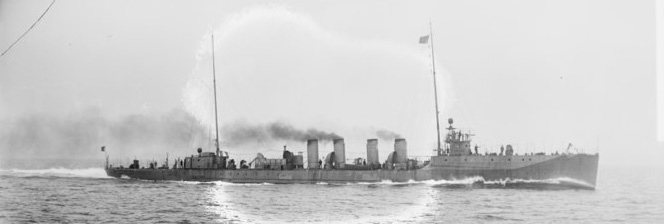
USS Cassin, date unknown
USS Cassin was commissioned on 9 August 1913, her first captain was Lieutenant Commander Harris Laning. She started training with the Atlantic Torpedo Flotilla.
Later she moved to Key West in Florida and from 5 December 1913 to 16 June 1914 she operated with the 6th Division in the Caribbean, and Gulf of Mexico in maneuvers. On 19 May she was dispatched to recue passengers of SS Atlantis which sunk north of Tampico. After her post-shakedown overhaul, Cassin stayed along the east coast until 27 January 1915 abnd took part in the Carribean winter maneuvers.
Soon after the US entered war, she started neutrality patrols in and from the Caribbean and later prepared for overseas service. She crossed the Atlantic to Queenstown in Ireland where most USS DDs were stationed for atlantic convoy escprt service and western approaches waters patrols against U-Boats. on 17 May, she started her first American troopships convoy, ventilated to England and France. On 15 October, she spotted U-61, some 20 nmi south of Mine Head Lighthouse, Monagoush (County Waterford) in Ireland. A chase began but she lost her from view an at 13:30, she was hit on her port stern by a torpedo. There, it ignited several depth charges, killing Gunner’s Mate First Class Osmond Ingram. The latter (posthumously awarded the MoH) saw where the torpedo was coming and started to throw the DCs overboard but was still here when it hit.
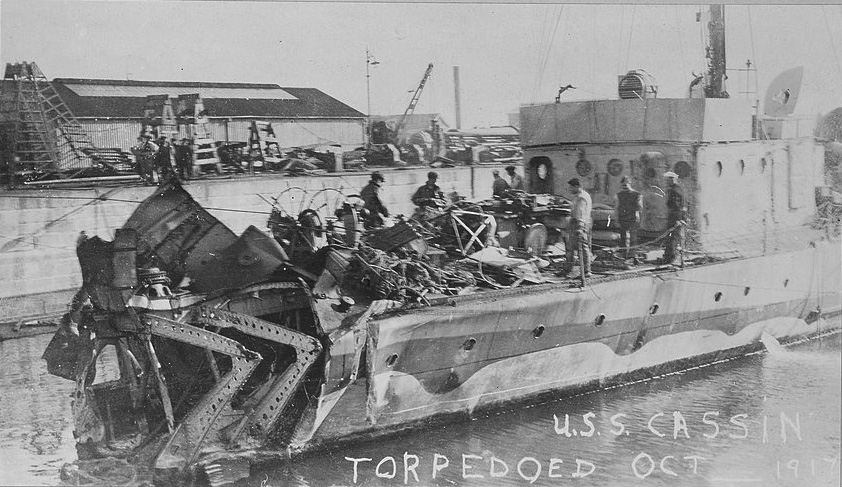
USS Cassin’s mushed stern 1917,which allows to see her peculiar triangular framing
Nine other were wounded but there was no more victim but Dudley Walton Queen by his wounds later.
USS Cassin had her rudder blown off, stern mushed, and started to circle, while still firing on the U-Boat until she submerged. She was assisted by USS Porter and HMS Jessamine, HMS Tamarisk until the morning, towed back in Queenstown. After repairs in Newport she was back escorting on 2 July 1918.
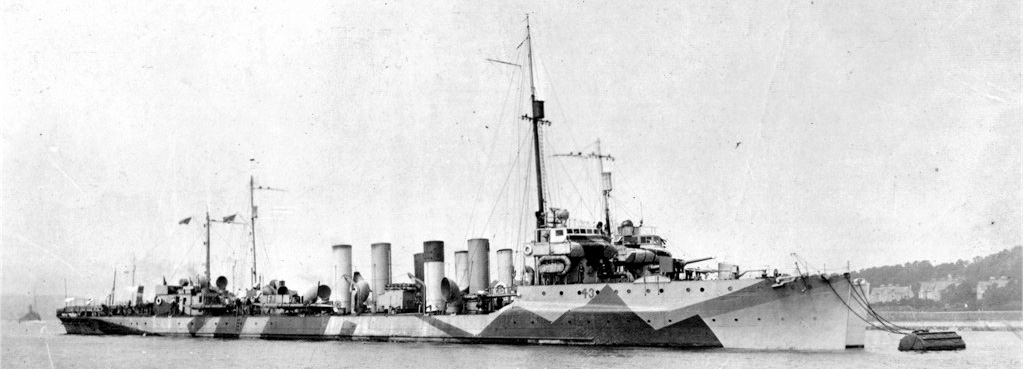
On 12–13 December 1918 she escorted SS George Washington carrying President Woodrow Wilson into Brest in France for the Versailles Peace Conference. She was back to Boston on 3 January 1919, resumed her training career in the Caribbean and assisted the transatlantic NC-4 flight. She was overhauled in Philadelphia on 18 June. From 14 February 1921 she joined the Flotilla 5 training off New England and was decommissioned again in Philadelphia on 7 June 1922. On 28 April 1924 she started her service with the Coast Guard as CG-1 after a refit in Maine and based in New London for the “Rum Patrol” and with Division 3 as flagship, decommissioned a final time in Philadelphia by 5 June 1933.
Stricken on 5 July 1934 she was sold on 22 August 1934 and BU.
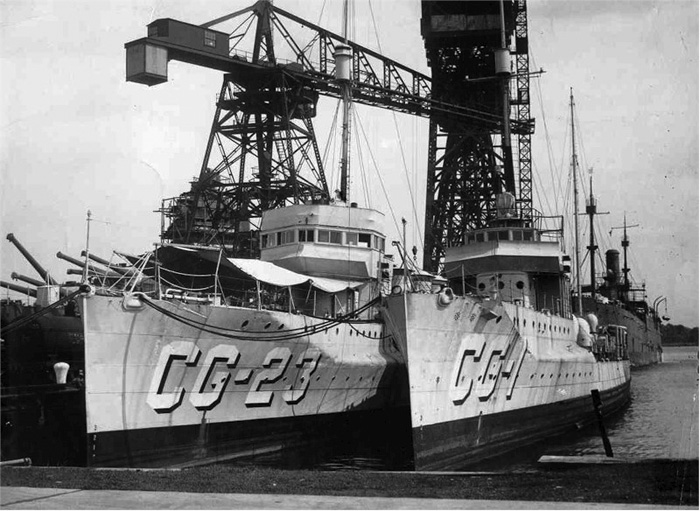
USCG Tucker and Cassin in the interwar, prohibition partrols
 USS Cumming DD44
USS Cumming DD44
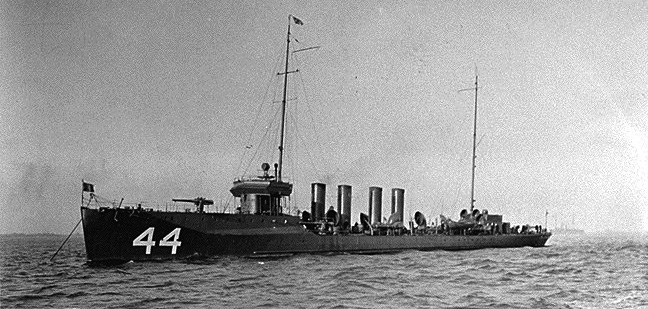
USS Cumming was commissioned on 19 September 1913, trained in the Caribbean and from June 1915, joined the Neutrality Patrol. She was in New York Navy Yard on 12 May 1917, refitted for overseas service and sailed for Queenstown, arriving on 26 May under command of Henry Kent Hewitt (future admiral). Between escort and anti-submarine patrols off the southern Irish coast she had 14 encounters with U-Boats. She also escorted in 1918 SS George Washington to France.
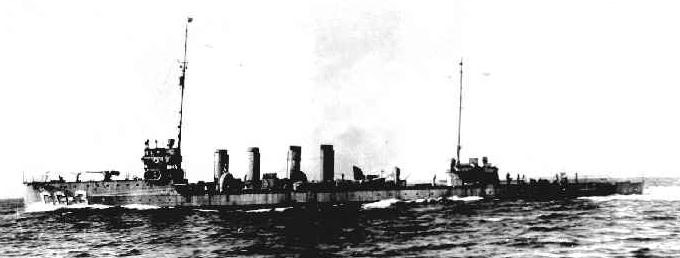
USCG-3 Cummings during the rum patrols
Departing on 16 December 1918 she resumed peactime service in Guantanamo Bay, Newport, in reserve for a short time in Philadelphia, back in operation off the east coast and decomm, again in Philadelphia on 23 June 1922. She also served with the Treasury Department (Coast Guard) from 6 June 1924 from New London. Stricken on 23 May 1932 she was sold for BU on 22 August 1934.
 USS Downes DD45
USS Downes DD45
USS Downes was commissioned on 11 February 1915. After her shakedown off New York and the Chesapeake Bay, her training off new england, she was refitted in Philadelphia from 4 October 1915 to 26 May 1917 for distant service and sailed from New York (18 October 1917) for Devonport (7 November) and then Queenstown (17th) and until 5 December 1918, operated in convoy escort, notably across the channel. She made a dozen spotting and attacks with no sure result but also aided distressed ships. She also won British commendations when protecting the torpedoed HMS Manley and rescue and salvage of a British submarine.
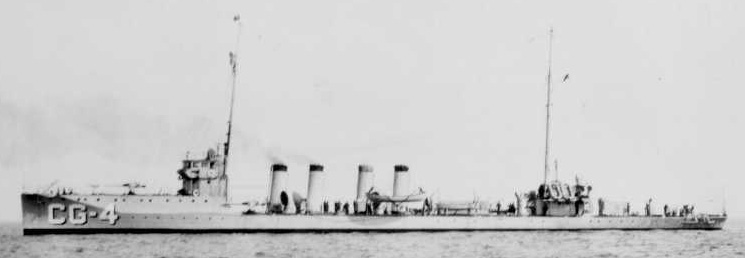
USS Downes as Coast Guard ship CG-45
In late December she departed back in Norfolk and from January 1919 alternatied between the Carribean, New York and Norfolk, for an overhaul. She was later back to Newport and Charleston in 1922 for exercizes. Decommissioned in Philadelphia in June she was reactivated for the coast guard on 28 April 1924 but at first as Academy practice ship and later, Rum Patrol. Back to Philadelphia in May 1931, she was stricken and sold for BU on 22 August 1934.
 USS Duncan DD46
USS Duncan DD46

USS Duncan was commissioned on 30 August 1913, with Lieutenant Commander C. E. Courtney in command. After her carribean shakedown and training on the East Coast she was decommissioned for a refit in Boston and back in neutrality patrol from January 1916 from Rhode Island. In addition of fleet manoeuvers with battleships and patrolling the entrance to the York River from 8–30 September 1917, she escorted a convoy.
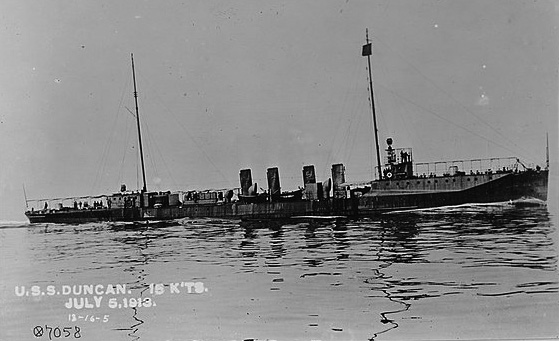
USS Duncan – NARA
Next she was prepared in NY for Irish service, departing at first to Brest from 30 October 1917. From 15 November she started her convoy escort, making several sightings and attacks. On 17 July 1918 she rescued survivors of the Norwegian bark Miefield and later Shaw. She also escorted SS G.Washington and by December 1918, left Queenstown for home, Norfolk.
She spent five months training off the East Coast and Caribbean, decomm. from 1st January 1920 and full reserve in August. After a long period she was stricken, sold and scrapped on 8 March 1935.
 USS Aylwin DD-47
USS Aylwin DD-47
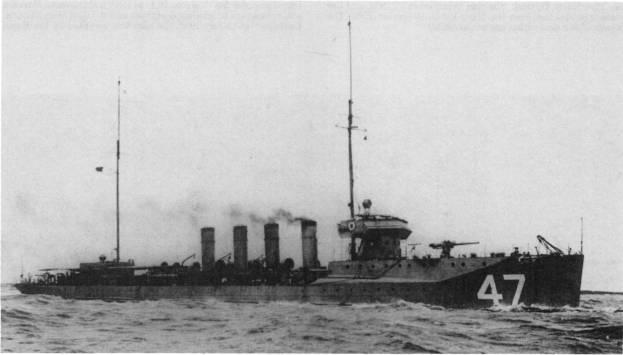
USS Aylwin was commissioned on 17 January 1914 (Lt. Cdr. Leigh C. Palmer, former aide of U.S. Secretary of the Navy Josephus Daniels). She made her shakedown to Cuba and trained off the North Carolina coast, training with sisters Benham and Parker. During one of these she suffered an internal explosion 15 nm off the Diamond Shoals lightship, in her forward fire room. She had three wounded, one later died. She was towed into Norfolk by USS Parker and the tug Sonoma on 7 April for repairs. According to the captain she was flooded so much she barely had five hours of buoyancy to spare.
A short enquiry determined faulty metal in her No. 1 boiler’s mud drum was the probable cause and her whole machinery was carefully monitored for defects; Repairs dragged one for more than a year at Norfolk, being recommissioned on 25 May 1915, 6th TBD Division, Atlantic Fleet. After retraining on the east coast she took part in Neutrality Patrols, based from Newport, Rhode Island by early October 1916. At 05:30 on 8 October reports of a U-Boat near the Lightship Nantucket (off Long Island) and British SOS she was rushed to investigate by Rear Admiral Albert Gleaves.
She arrived on the scene on 17:00 and caught U-53 (Kapitänleutnant Hans Rose) red-handed, after stopping the Holland-America Line Blommersdijk, the passenger ship Stephano and three other ships. But the destroyer had strict neutrality rules observances and could only respond to Rose’s signal to the destroyer to move away from Stephano for him to torpedo the ship after gathering the crew. Aylwin complied and gathered in turn the 226 survivors from various U-Boat victims. This “attitude” was criticized at the house of Lords.
In early 1917, USS Aylwin was back in manoeuvers, and off the Virginia capes by April.
From June 1917 to January 1918 unlike her sisters she was not sent to Europe but instead was used for special experimental work led by Reginald Fessenden, off Boston and Newport. On 4 January 1918, at last she sailed for Queenstown after some patorls, was detached to join the RN in Portsmouth and Devonport, learning new ASW patrol drills.
On 26 December 1918, she sailed with USS Chester for the Baltic, toured German ports and escorted some war prize ships, as part of the Inter-Allied Naval Armistice Commission. By May 1919, she was based in Brest and later Antwerp. She was back in New York on 26 June and inactivated in Philadelphia, decommissioned on 23 February 1921. Renamed on 1 July 1933 (new Mahan class destroyer renamed after her) “DD-47” was stricken on 8 March 1935, sold for BU on 23 April.
 USS Parker DD-48
USS Parker DD-48
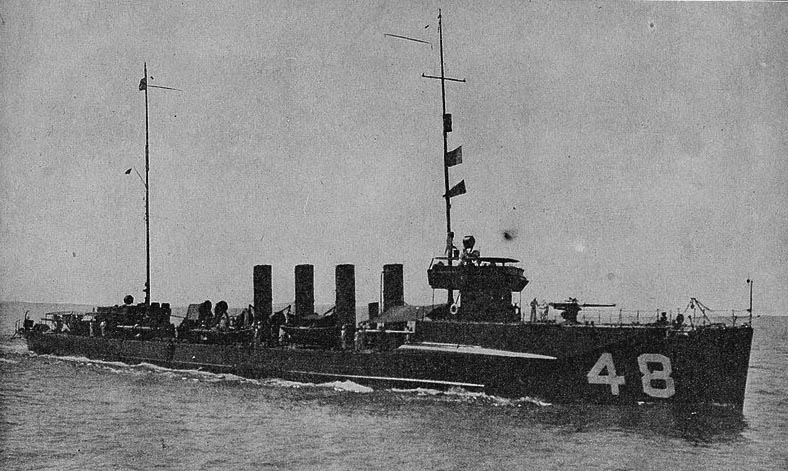
Commissioned in January 1914, USS Parker assisted Aylwin after her dramatic explosion in April.
In early April 1915 with USS McDougal she was sent to patrol near the New York City Quarantine Station. It was suspected that Dudley Field Malone (local port collector) would allow after a bribe interned German steamships at New York to slip out, using a heavy snowstorm as cover. The New York Times titled also a “widespread conspiracy” as NY ships at the contrar were supplying British warships outside U.S. territorial waters…
USS Parker went through the usual Carribean-East Coast training routine and neutrality patrols. From April 1917, she was part of the fourth group, escorting the first troopship convoy to Europe. She was relocated to Queenstown and made many patrols, a few sighting, no sure kill. She rescued 9 survivors of a torpedoed British hospital ship in February 1918, being congratulated by the British Parliament and U.S. Navy officials. She had a probable “kill” or at least sever damage to an U-Boat on 3 August 1917. As the others in late 1918 she was moved to Brest and Antwerp.
She was back home July 1919, Atlantic Fleet and resuming peactime training.
In July 1920, she was sent to the Mediterranean, searching a missing American missionary couple (Paul Nilson and Harriet Fisher Nilson) thought abducted by Turkish Nationalists. She located them later was while off Mersina demanded under the cover of her guns, their release, dispatching messages by airplane to Tarsus and Adana.
Decommissioned in June 1922, she was kept in reserve until stricke March 1935, sold for BU in April.
 USS Benham DD-49
USS Benham DD-49
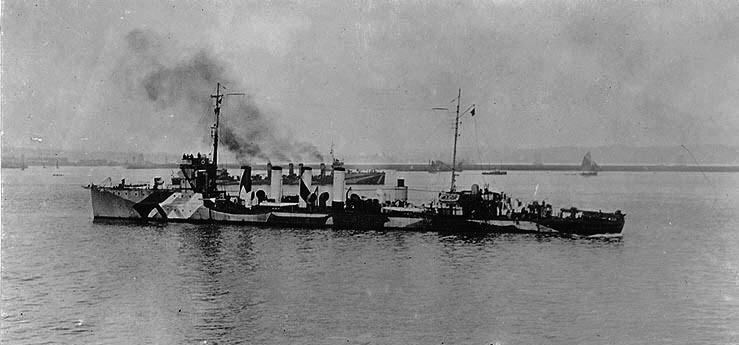
USS Benham was commissioned on 20 January 1914 under command of Lt. Cdr. Charles J. Train. In February-March she made a shakedown cruise to the West Indies. From April she trained off Hampton Roads with USS Aylwin and Parker, assiting the first after her boiler explosion. In August 1916, she took part in the largest USN war game to date, scouting for “Blue force” and first to spot the inbound “Red” transports and escorts.
After her tour of duty in Neutrality Patrols from Newport, on 8 October, wireless reports signalled an U-Boat near the Lightship Nantucket (U-53) and later evacuated part of the 226 survivors she carried. From 6 April 1917 she was one of the first chosen to be sent in Europe, departing Tompkinsville, New York on 17 May for Queenstown. On 13 July she reported her attack by two U-Boats, spotting three torpedoes, evaded. She had them repelled by agressive depth charge attacks. On 30 July she spotted the wake of another torpedo 1,500 yd away and charged to the attack with guns and depth charges, spotting later air bubbles and surfaced oil, gaining a “probable” damage. By June 1918 she was sent to Brest until December.
In September however she was was rammed by the British Azalea-class sloop HMS Zinnia (future flagship of the Belgian Navy).
On 21 December she left for home, Atlantic Fleet for the annual fleet maneuvers and a trip to the Azores in May 1919. Place in provisional decomm. in Norfolk on 28 June and back in service in 1921, on the eastern seaboard, plane guard and tender for the Atlantic Fleet Air Squadrons until May 1922. She was inactivated and later decomm. in Philadelphia, stricken on 8 March 1935 and BU.
 USS Balch DD-50
USS Balch DD-50
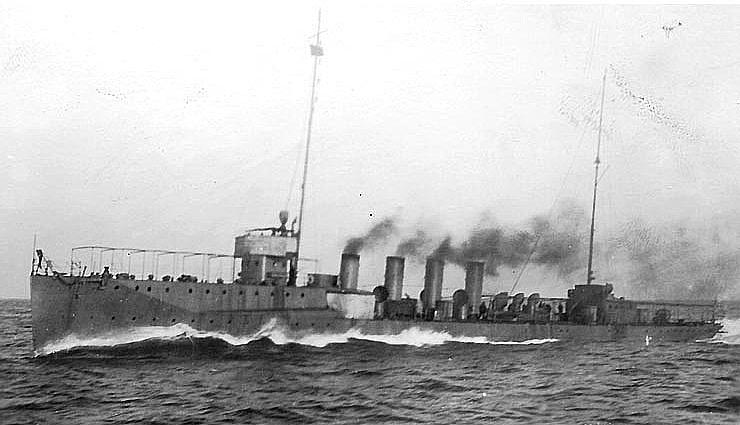
USS Balch was commissioned on 26 March 1914 (Lt. Cdr. David C. Hanrahan).
After shakedown and Carribean training with the Torpedo Flotilla, Atlantic Fleet, she took part in a Presidential Fleet Review on 7 May in NYC. She would take part also in Narragansett Bay maneuvers organized by the Naval War College. After a short decommissioned in July-December 1914 she resumed her training. In June 1915 one of her torpedoes was unloaded at the Brooklyn Navy Yard as a display for the “Peace and Preparation” conference of the National Security League. In 1916 she served as an observation platform for the Seawanhaka-Corinthian Yacht Club’s annual regatta. After Neutrality Patrols from Newport, on 8 October 1916 she took part in the action which implied U-53, alsop picking up part of the crews of the sunken ships.
From April 1917, USS Balch was refited with depth charge racks, a new bridge and other modifications for her overseas deployment, to Queenstown from 17 November. She started her first patrol on 24 November, having later two encounters with German submarines. On 29 January 1918 off Liverpool and on 12 May, while escorting convoy HS 60; No kill, but she drove the latter off.
On 20 October 1918 she collided with USS Balch during a convoy in foul weather, which had her port depth charge knocked overboard, fortunately set to “safe” by three of the crew seeing the immiment collision. They earned commendations later. The destroyer still suffered steering gear damage, being repaired in Queenstown. On 5 November she helped USS Sterett rescuing 29 survivors from the cargo Dipton. She left Ireland for hime, Norfolk, on 16 November via Ponta Delgada in the Azores.
Fully recommissioned by early April she was back in normal drills routines on the West Indies and east coast. After an overhaul by July 1920 she was renamed “DD-50” and was left in port due to funding shortages, resuling service with the Torpedo Flotilla before inactivation, decommission at Philadelphia (20 June 1922), stricken on 8 March 1935, sold for BU on 23 April.


 Latest Facebook Entry -
Latest Facebook Entry -  X(Tweeter) Naval Encyclopedia's deck archive
X(Tweeter) Naval Encyclopedia's deck archive Instagram (@navalencyc)
Instagram (@navalencyc)





 French Navy
French Navy Royal Navy
Royal Navy Russian Navy
Russian Navy Armada Espanola
Armada Espanola Austrian Navy
Austrian Navy K.u.K. Kriegsmarine
K.u.K. Kriegsmarine Dansk Marine
Dansk Marine Nautiko Hellenon
Nautiko Hellenon Koninklije Marine 1870
Koninklije Marine 1870 Marinha do Brasil
Marinha do Brasil Osmanlı Donanması
Osmanlı Donanması Marina Do Peru
Marina Do Peru Marinha do Portugal
Marinha do Portugal Regia Marina 1870
Regia Marina 1870 Nihhon Kaigun 1870
Nihhon Kaigun 1870 Preußische Marine 1870
Preußische Marine 1870 Russkiy Flot 1870
Russkiy Flot 1870 Svenska marinen
Svenska marinen Søværnet
Søværnet Union Navy
Union Navy Confederate Navy
Confederate Navy Armada de Argentina
Armada de Argentina Imperial Chinese Navy
Imperial Chinese Navy Marinha do Portugal
Marinha do Portugal Mexico
Mexico Kaiserliche Marine
Kaiserliche Marine 1898 US Navy
1898 US Navy Sovietskiy Flot
Sovietskiy Flot Royal Canadian Navy
Royal Canadian Navy Royal Australian Navy
Royal Australian Navy RNZN Fleet
RNZN Fleet Chinese Navy 1937
Chinese Navy 1937 Kriegsmarine
Kriegsmarine Chilean Navy
Chilean Navy Danish Navy
Danish Navy Finnish Navy
Finnish Navy Hellenic Navy
Hellenic Navy Polish Navy
Polish Navy Romanian Navy
Romanian Navy Turkish Navy
Turkish Navy Royal Yugoslav Navy
Royal Yugoslav Navy Royal Thai Navy
Royal Thai Navy Minor Navies
Minor Navies Albania
Albania Austria
Austria Belgium
Belgium Columbia
Columbia Costa Rica
Costa Rica Cuba
Cuba Czechoslovakia
Czechoslovakia Dominican Republic
Dominican Republic Haiti
Haiti Hungary
Hungary Honduras
Honduras Estonia
Estonia Iceland
Iceland Eire
Eire Equador
Equador Iran
Iran Iraq
Iraq Latvia
Latvia Liberia
Liberia Lithuania
Lithuania Mandchukuo
Mandchukuo Morocco
Morocco Nicaragua
Nicaragua Persia
Persia San Salvador
San Salvador Sarawak
Sarawak Uruguay
Uruguay Venezuela
Venezuela Zanzibar
Zanzibar Warsaw Pact Navies
Warsaw Pact Navies Bulgaria
Bulgaria Hungary
Hungary

 Bundesmarine
Bundesmarine Dutch Navy
Dutch Navy Hellenic Navy
Hellenic Navy Marina Militare
Marina Militare Yugoslav Navy
Yugoslav Navy Chinese Navy
Chinese Navy Indian Navy
Indian Navy Indonesian Navy
Indonesian Navy JMSDF
JMSDF North Korean Navy
North Korean Navy Pakistani Navy
Pakistani Navy Philippines Navy
Philippines Navy ROKN
ROKN Rep. of Singapore Navy
Rep. of Singapore Navy Taiwanese Navy
Taiwanese Navy IDF Navy
IDF Navy Saudi Navy
Saudi Navy Royal New Zealand Navy
Royal New Zealand Navy Egyptian Navy
Egyptian Navy South African Navy
South African Navy






























 Ukrainian Navy
Ukrainian Navy dbodesign
dbodesign